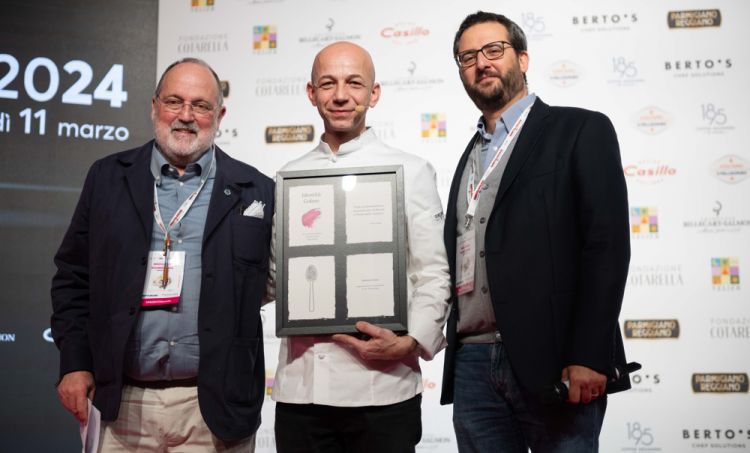'The theme of this year's congress has put me strongly in crisis'. From the stage of the Identità Milano 2024 auditorium, Riccardo Camanini, chef and owner of restaurant Lido 84 in Gardone Riviera, explains his discomfort at wearing the cloak of disobedience: 'The kitchen is the place I love and it is difficult to rebel against something you love. I never throw flour in the air or break a plate out of anger'. This is how the toque of the seventh-ranked World's 50Best establishment talks about the most important challenge for a cook: interpreting ingredients that disobey the initial idea of a dish.
The first dish Camanini illustrated has distant roots: 'I reread a recipe from the 1500s by Bartolomeo Scappi, known as "the cook of the Popes" and author of Opera, a fundamental book for cooks.
How to make a Milanese style soup of “struccato” cabbage. The title of the preparation prompts some questions: 'It was immediately obvious that it was a forerunner of
cassœula. I did some research and found that
struccare, in the 1500s, meant to
squeeze, to
compress'. This is disobedience, the root of culture, from which sharp ideas are born: reinterpreting a recipe from five centuries ago, starting from the meaning of words. And adding three elements borrowed from phytotherapy and perfumery: mother tinctures, dry extract and benzoin tears.
‘Mother tinctures are probably the most precise synthetic solution of a plant. The dry extract is something even more profound, because it is the mother tincture after the alcoholic part has evaporated. Benzoin tears, typical of Asian areas, are resins collected from a plant (Styrax, ed.) rendered into powder and are an excellent fixative for perfumes.’
Reinterpreting a dish based on pork broth and cabbage
stew. It starts with a fresh pasta from the Bergamo tradition made with a kilo of flour, two eggs and a little water: 'We rolled it out thinly and brushed it with a tincture of woodruff, which gives it an extremely herbaceous scent and a slightly bitter taste. The dough is sprinkled with dried cabbage, dried broccoli extract, dill extract powder and benzoin tears to fix the fragrance.’
The colourful and fragrant pastry sheets have an intense flavour due to the herbs. The broth is made with pork ribs cooked overnight on hot embers and then simmered with cabbage, onion, lemon leaves, honey, mustard, ginger and lemongrass berries. More dried cabbage will be steeped in the broth. Casoncello alla bergamasca is a poor pasta that is extremely chewy. It is steamed, left to dry and wrapped around itself to create a bite. It is supposed to remind one of a compressed struccata cabbage as we imagined it in the recipe.'
The dish is served in four different elements: a mouthful of pasta, broth, white and red cabbage marinated with a mother tincture of milk thistle and dried cabbage leaves: 'The intention was to present a pasta dish that could be eaten with your hands to feel the chewiness of poor pastas from Bergamo and to give the pasta compressed
struccata feel.
The second work presented on stage by the chef from Lovere recounts the origin of a dish presented at
Lido 84 in June 2014, the year it opened, and which has become a symbol of the restaurant and its chef,
Spaghetti with butter and yeast: 'The first version of this dish was
Spaghetti with butter and camomile. It was May, the camomile flowers were starting to appear, we picked them, removed the petals, dried the central yellow part in the oven and added the powder to the dish.’
But something was missing: 'What made this dish significant was the use of the dry extract, a synthesis of the active ingredients and essential oils of a plant.’ The difference is that, in contact with heat, a powder remains stable while an extract dissolves the essential oils: 'As these are two fat-soluble elements, coming into contact with another fat, the extract gives an amber effect to the spaghetti, so we won't find a powdery sensation on the palate and the olfactory perception will be much more noticeable with a more interesting aesthetic effect.’
In the third dish of the session,
Camanini uses hawthorn mother tincture, which gives a strongly lactic note on the palate. A risotto cooked in stockfish stock and mixed with a stockfish oil mayonnaise: 'The dish had a strong lactic sensation and I wanted to combine it with a fruit that could give a very delicate hint of acidity.’ The dish is served: rice, stockfish, banana and hawthorn mother tincture.

Camanini with Paolo Marchi and Niccolò Vecchia, who presented the talk
Taking a recipe from the 1500s, analysing its words, breathing its soul, reinventing, lightening, extracting and concentrating the scents and flavours of nature. This is disobedience, this is the world of
Riccardo Camanini.
Translated into English by Slawka G. Scarso